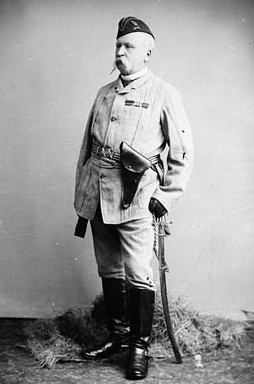Frederick Dobson Middleton facts for kids
Quick facts for kids
General
Sir Frederick Dobson Middleton
KCMG, CB
|
|
|---|---|

Sir Frederick Middleton
|
|
| Born | 4 November 1825 Belfast, Ireland |
| Died | 25 January 1898 (aged 72) London, England |
| Allegiance | United Kingdom Canada |
| Service/ |
British Army Canadian Militia |
| Years of service | 1845–1869 |
| Rank | General |
| Commands held | Royal Military College, Sandhurst General Officer Commanding the Canadian Militia |
| Battles/wars | New Zealand Wars Indian Mutiny North-West Rebellion |
| Awards | Knight Commander of the Order of St Michael and St George Companion of the Order of the Bath |
General Sir Frederick Dobson Middleton (4 November 1825 – 25 January 1898) was a British general. He was known for his service across the Empire, especially in Canada during the North-West Rebellion.
Contents
Early Military Career
Frederick Middleton went to Maidstone Grammar School and the Royal Military College, Sandhurst. He became an officer in the 58th Regiment of Foot in 1842.
Service in New Zealand and India
Middleton served in the New Zealand Wars. In 1845, he was praised for his role in capturing a stronghold belonging to the Māori chief Te Ruki Kawiti.
In 1848, he moved to the 96th Regiment of Foot in India. He helped put down the Indian Mutiny. He was even suggested for the Victoria Cross, a very brave award, but he did not receive it. Later, in 1879, he became the leader of the Royal Military College, Sandhurst.
Leading the Canadian Militia
In 1884, Middleton was chosen to be the General Officer Commanding the Militia of Canada. This meant he was in charge of Canada's part-time army.
The North-West Rebellion
In 1885, a group of Métis people in Canada started the North-West Rebellion. Middleton was already in Canada and was quickly put in charge of the main army sent to stop it. His forces won the Battle of Batoche, which ended the rebellion.
Middleton was in Winnipeg to check on a military district when the rebellion began. The first battle, the Battle of Duck Lake, happened that same day. Métis fighters defeated a group of the North-West Mounted Police.
Even though Middleton was older and careful, he acted quickly. He left Winnipeg by train with soldiers from Manitoba.
Challenges of Mobilization
A big challenge for Middleton was getting soldiers from Ontario and Quebec. They had to travel on the Canadian Pacific Railway, which was not yet finished. This meant the soldiers had to march through snow and rocks in northern Ontario to reach Winnipeg.
A Canadian historian named Desmond Morton said Middleton was an experienced soldier. He was a mix of common sense and a bit of a show-off. Middleton's plan was to capture Batoche, the main place for the Métis leaders. He believed this would end the rebellion quickly. The Canadian Prime Minister, Sir John A. Macdonald, wanted the rebellion to end fast. This was because it was making other countries worry about Canada's financial stability.
Many of the soldiers arriving in Winnipeg were not trained. Middleton had to train them as they marched towards the fighting.
Key Battles and Strategy
On April 6, 1885, Middleton began his march to Batoche. On April 23, 1885, the Métis and Cree, led by Gabriel Dumont, surprised the Canadians at Fish Creek.
Another Canadian officer, Colonel William Dillon Otter, went against Middleton's orders. He attacked the Cree and was defeated by Chief Poundmaker at the Battle of Cut Knife Hill. The Canadians were saved from total defeat only because Poundmaker did not want his warriors to chase them.
Middleton was careful and waited for river steamers to bring supplies. He knew the Métis and Cree were excellent horse riders. He believed they would ambush any supply wagons, so he preferred to use the river for supplies and reinforcements.
On May 5, 1885, the steamer Northcote was ready. Middleton set off for Batoche. On May 9, the Northcote was stopped by a cable Dumont had placed across the river near Batoche. The boat's captain turned back when it came under fire. The Northcote was a distraction to draw out the Métis. At the same time, Middleton's main force arrived at Batoche.
Middleton saw his troops starting to panic. He ordered his wagons to form a circle for defense. On May 11, Middleton noticed that the Métis and Cree were outnumbered and had to move quickly between positions. On the morning of May 12, Middleton ordered his artillery to fire to keep the enemy pinned down while his infantry advanced.
At first, the attack did not go well. Middleton accused his men of being afraid. He ordered another attack that afternoon. A battalion led by Colonel Arthur Williams, a politician, bravely led the charge. Inspired by Williams's group, other battalions also charged forward. The Canadians rushed down the hill, and the Métis and Cree were soon defeated.
After the Rebellion
Historian Desmond Morton described Middleton as a cautious but very skilled officer. He was a better tactician than Dumont. Middleton brought the war to a quick end, with less bloodshed than there could have been.
For his service in the war, Queen Victoria made Middleton a knight in 1885. He also received thanks from the Parliament of Canada and a sum of $20,000.
He left his role as head of the militia in 1890. This happened after a report from the House of Commons criticized him. The report said he had taken furs from a man named Charles Bremner and his wife during the rebellion. There were also other criticisms about his leadership, such as his hesitation to attack at Batoche and how his troops were treated. After returning to England, he became the Master of the Jewel Office.
Images for kids


